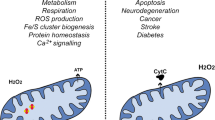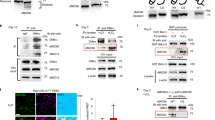Summary
Anthralin is an inhibitor of oxidative phosphorylation at concentrations found in vivo. ADP-stimulated oxygen consumption is diminished. Consequently, the rate of ATP synthesis is reduced and mitochondrial ATP content declines. Neither the isolated ATPase (F1Fo-ATPase), nor the mitochondrial membrane-bound ATPase are influenced by the drug. Respiration under resting conditions is not affected. The experimental data unequivocally indicate that anthralin is not an uncoupler of oxidative phosphorylation, as previously stated. Furthermore, the interpretation that respiratory deficiency induced in yeast strains by anthralin is a consequence of petite mutations has to be reconsidered. Under in vivo conditions, anthralin inhibits respiration per se. Our experiments, including the electron spin resonance spectroscopy, reveal that anthralin alters mitochondrial membrane structure and function simultaneously. A redox or free-radical mediated step may be involved. In consequence, inhibition of ATP production occurs which may become the limiting factor for increased cellular metabolism in psoriasis.
Similar content being viewed by others
References
Ashton RE, Andre P, Lowe NJ, Whitefield M (1983) Anthralin: historical and current perspectives. J Am Acad Dermatol 9:173–192
Bernd A, Holzmann H, Marsch WC, Kurulec B, Britivic S, Müller WEG (1985) The anti-psoriatic compound dithranol is not a mutagen in the Ames test and exhibits even some antimutagenic activity. 13. Jahrestagung der Arbeitsgemeinschaft Dermatologische Forschung, November 15–17, 1985, Vienna
Caron JC, Eustache J, Shroot B, Prota G (1982) On the interaction between mitochondria and DNA: a revision. Arch Dermatol Res 274:207–212
Estabrook RW (1967) Mitochondrial respiratory control and polarographic measurement of ADP/O ratios. Methods Enzymol 10:41–47
Fuchs J, Mainka L, Zimmer G (1985) 2-Mercaptopropionyglycine and related compounds in treatment of mitochondrial dysfunction and postischemic myocardial damage. Arzneimittle Forsch 35:13941402
Gillberg BO, Zetterberg G, Swanbeck G (1967) Petite mutants induced in yeast by dithranol (1,8,9-trihydroxyanthracene), an important therapeutic agent against psoriasis. Nature 214:415
Hammar H (1975) Epidermal activity of NAD dependent isocitrate dehydrogenase in psoriasis during treatment with dithranol. J Invest Dermatol 65:315–319
Hanstein WG (1976) Uncoupling of oxidative phosphorylation. Biochim Biophys Acta 456:129–148
Heytler PG (1979) Uncouplers of oxidative phosphorylation. Methods Enzymol 55:462–472
Kammerau B, Zesch A, Schaefer H (1975) Absolute concentrations of dithranol and triacetyl-dithranol in the skin layers after local treatment: in vivo investigation with four different types of pharmaceutical vehicles. J Invest Dermatol 64:145–169
Leonhardi G (1961) Die Beeinflussung von Atmung und Glycolyse der Haut durch verschiedene Pharmaka. ARch Klin Exp Dermatol 213:839–844
Lowry OH, Rosebrough NJ, Farr AL, Randall RJ (1951) Protein measurement with the Folin phenol reagent. J Biol Chem 193:265–275
Martinamaa J, Juselius J, Mustakallio KK (1981) Free radicals by auto-oxidation of anthralin and its 10-acyl analogues. Br J Dermatol 105 [Suppl 20]:52
Melo TSE, Dubertret L, Prognon P, Gond A, Makuzier G, Santus R (1983) Physicochemical properties and stability of anthralin in model systems and human skin. J Invest Dermatol 80:1–6
Morliere P, Dubertret L, Melo TSE, Salet C, Fosse M, Santus R (1985) The effects of anthralin (dithranol) on mitochondria. Br J Dermatol 112:509–515
Mustakallio KK (1981) Irritation, staining and antipsoriatic activity of 10-acyl analogues of anthralin. Br J Dermatol 105 [Suppl 20]:23–27
Pätel M, Schaarschmidt B, Reichert U (1981) Calorimetric and manometric measurements on human skin fibroblasts in culture. Br J Dermatol 105 [Suppl 20]:60–61
Pullmann ME, Penefsky HS, Datta A, Racker E (1960) Partial resolution of the enzymes catalyzing oxidative phosphorylation. J Biol Chem 235:3322–3329
Quintanilha A, Packer L (1976) Surface localization of sites of reduction of nitroxide spin labeled molecules in mitochondria. Biophys J 16:102a
Raab W (1975) Zur antipsoriatischen Wirkung von Dithranol (Anthralin). Hautarz 26:425–455
Raab WP (1981) Ingram method: the precursor of photochemotherapy. Br J Dermatol 105 [Suppl 20]:77–81
Raab W, Patermann F (1966) Die Wirkung externer Antipsoriatica auf die Zellatmung. ARch Klin Exp Dermatol 226:153–166
Reichert U, Jacques Y, Grangeret M, Schmidt R (1985) Antirespiratory and antiproliferative activity of anthralin in cultured human keratinocytes. J Invest Dermatol 84:130–134
Schalla W, Bauer E, Schaefer H (1981) Skin permeability of anthralin. Br J Dermatol 105 [Suppl 20]:104–108
Schröder JM, Kosfeld U, Christophers E (1985) Multifunctional inhibition by anthralin in nonstimulated and chemotactic factor stimulated human neutrophils. J Invest Dermatol 85:30–34
Serrano R, Kamer BF, Racker E (1976) Purification and properties of a proton translocating adenosine-triphosphatase complex of bovine heart mitochondria. J Biol Chem 251:2453–2461
Smith AL (1967) Preparation, properties and conditions for assay of mitochondria: slaughterhouse material, small scale. Methods Enzymol 10:81–86
Spielmann H, Jakob-Müller U, Schulz P (1981) Simple assay of 0.1–1.0 pmol of ATP, ADP and AMP in single somatic cells using purified luciferin luciferase. Anal Biochem 113:172–178
Swanbeck G, Thyresson N (1965) Interaction between dithranol and nucleic acids. Acta Derm Venereol 45: 344–348
Terada H (1981) The interaction of hingly active uncouplers with mitochondria. Biochim Biophys Acta 639:225–242
Thore A (1979) Technical aspects of the bioluminescent firefly luciferase assay of ATP. Science Tools 26:30–34
Veit P, Fuchs J, Zimmer G (1985) Uncoupler and hypoxia induced change in the working rat heart and its treatment. I. Observations with uncouplers of oxidative phosphorylation. Basic Res Cardiol 80:107–115
Verhaeren EHC (1980) The uncoupling activity of substituted anthracene derivatives on isolated mitochondria from phaseolus aureus. Phytochemistry 19:501–503
Verhaeren EHC (1980) Mitochondrial uncoupling activity as a possible base for a laxative and antipsoriatic effect. Pharmacology 20 [Suppl 1]:43–49
Weinbach EC, Garbus J (1969) Mechanism of action of reagents that uncouple oxidative phosphorylation. Nature 221:1016–1018
Zetterberg G (1977) Effects of an antipsoriatic agent, dithranol, on mitochondrial and nuclear functions in yeast cells. Hereditas 86:191–204
Zetterberg G (1981) Effects of anthralin on mitochondrial and nuclear functions in yeast cells. Br J Dermatol 105 [Suppl 20]:39–42
Zimmer G (1977) Carbonylcyanide-p-trifluoro-methoxyphenylhydrazone induced change of mitochondrial membrane structure revealed by lipid and protein spin labeling. Arch Biochem Biophys 181:26–32
Zimmer G (1984) Fluidity of cell membranes in the presence of some drugs and inhibitors. In: Kates M, Manson LA (eds) Membrane fluidity, biomembranes, vol 12. Plenum, New York, pp 169–203
Zimmer G, Keith AD, Packer L (1972) Effect of sucrose and uncouplers on lipid spin labeling of mitochondria. Arch Biochem Biophys 152:105–113
Author information
Authors and Affiliations
Rights and permissions
About this article
Cite this article
Fuchs, J., Zimmer, G., Wölbling, R.H. et al. On the interaction between anthralin and mitochondria: a revision. Arch Dermatol Res 279, 59–65 (1986). https://doi.org/10.1007/BF00404360
Received:
Issue Date:
DOI: https://doi.org/10.1007/BF00404360




